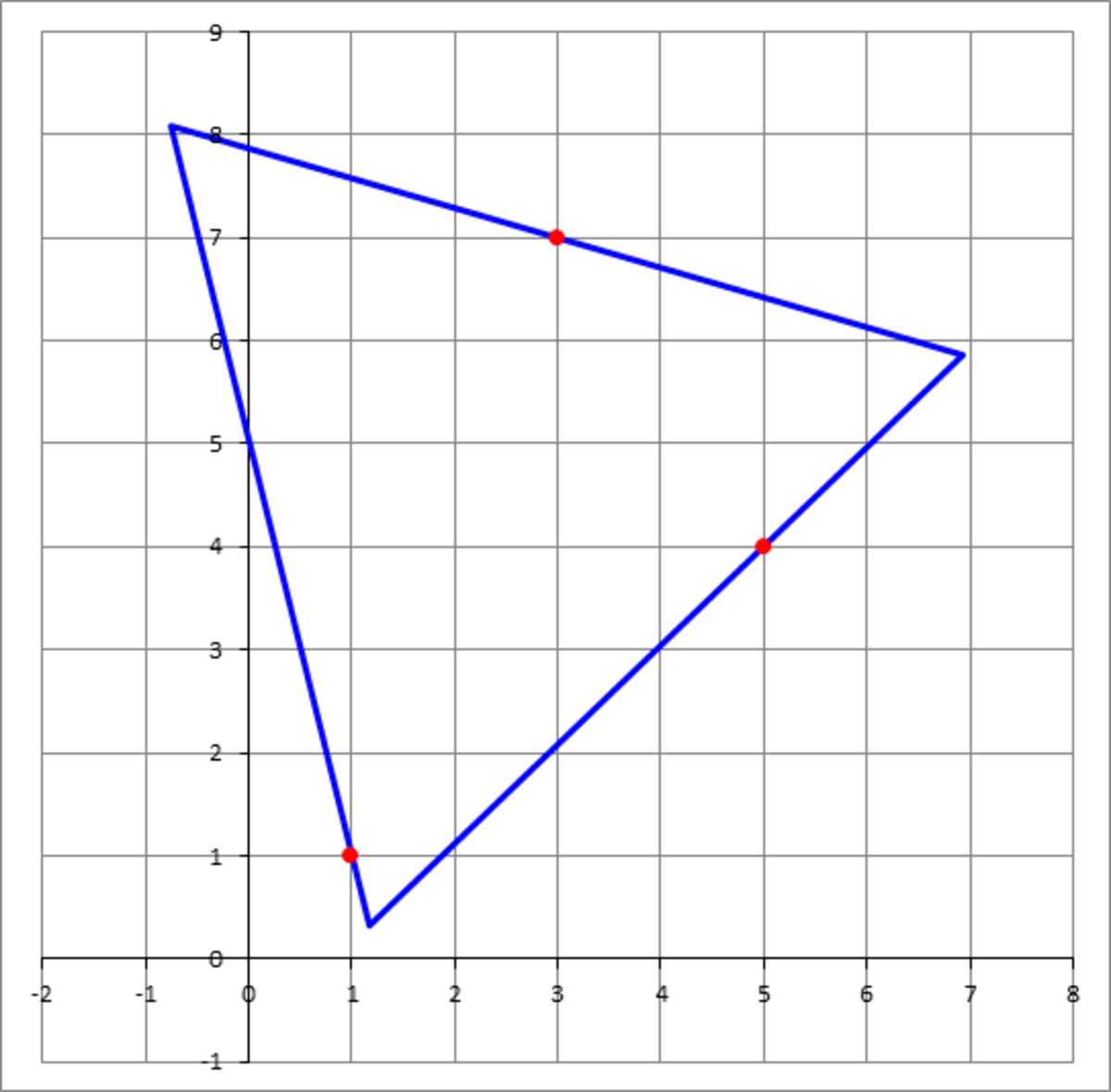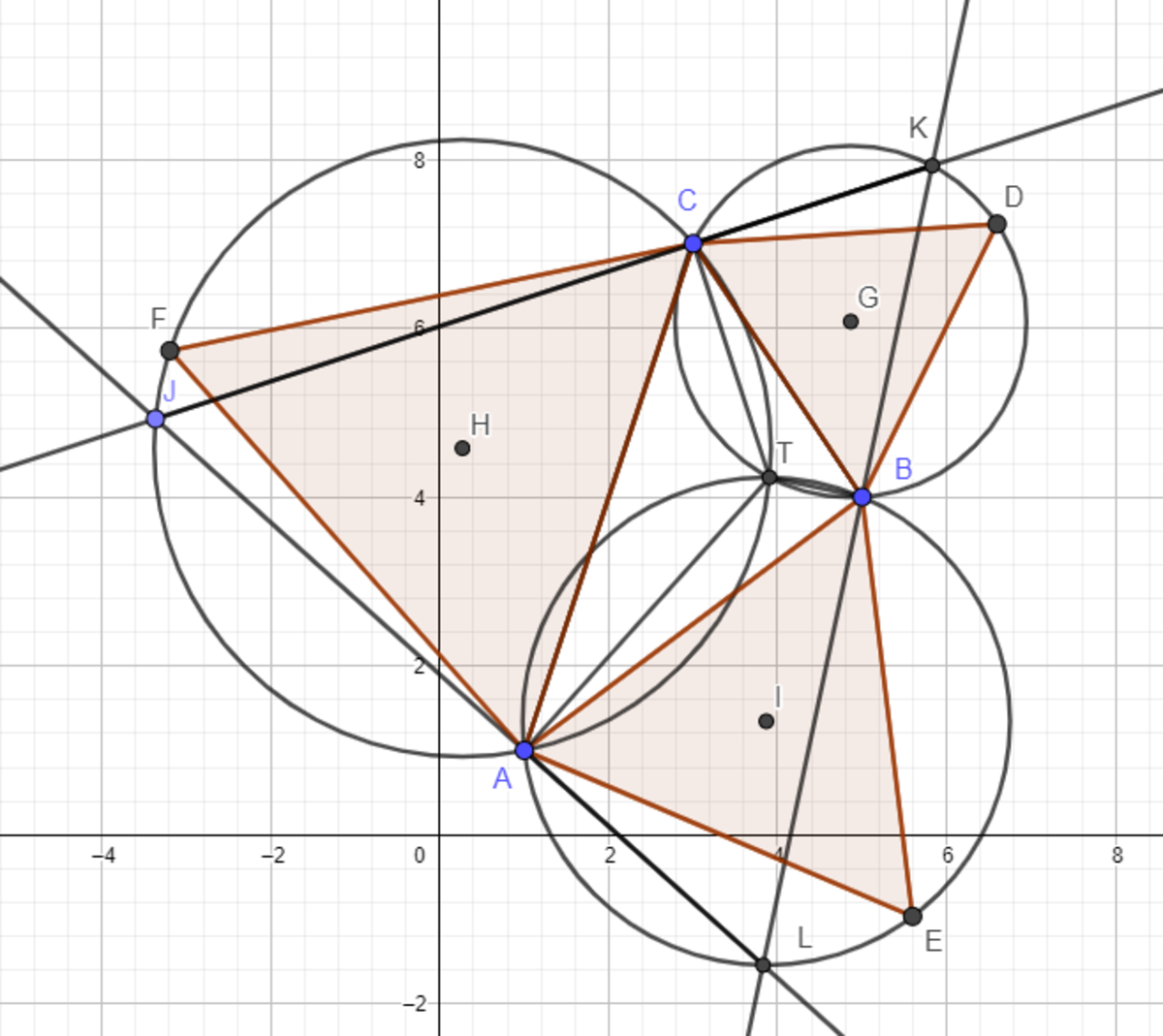Fitting an equilateral triangle to three points 3
Three points in the Cartesian plane are given by: A ( 1 , 1 ) , B ( 5 , 4 ) , C ( 3 , 7 ) . We want to draw an equilateral triangle of side length L that will pass through A , B and C , with one point on each side.
Here L m a x = A B + C D , and A , B , C , D are coprime integers, D square free, find A + B + C + D .

The answer is 24.
This section requires Javascript.
You are seeing this because something didn't load right. We suggest you, (a) try
refreshing the page, (b) enabling javascript if it is disabled on your browser and,
finally, (c)
loading the
non-javascript version of this page
. We're sorry about the hassle.
4 solutions
The largest such equilateral triangle is the antipedal triangle of the Fermat point. The area of this triangle is given by Δ ′ = 2 Δ ( 3 3 cot ω + 1 ) , where Δ is the area of triangle A B C , and ω is its Brocard angle.
Plugging everything in, we get Δ ′ = 1 8 + 1 3 3 . Then the side length of the equilateral triangle is 5 2 + 2 4 3 = 2 1 3 + 6 3 .
References:
https://www.cut-the-knot.org/Generalization/fermat_point.shtml
I think that side length is always twice the side length of the Napoleon triangle for the triangle ABC. The maximum triangle has sides parallel to the sides of the Napoleon's triangle. I do not have a proof for that though. Just an observation.

-
Find coordinates of Torichelli point T for A B C .
-
Find line J K , that point C belongs J K , and K , J belong to circles, J K and C T are ortogonal.
-
Length of J K - is answer.
Mathcad is used for coordinates calculation. And here Maria Kozlowska idea checked.
If the fitted triangle is centered at r 0 and tilted by an angle θ from the standard orientation, then using simple geometry on the equilateral triangle, we can write the following equation iterated for the three points.
( P i − r 0 ) T R ( θ ) v i = 2 3 1 L , i = 1 , 2 , 3
where { P i } are the three given points, and R ( θ ) is the standard 2D rotation matrix, and is given by
R ( θ ) = [ cos θ sin θ − sin θ cos θ ]
And the { v i } are three unit vectors pointing from the center of the equilateral in standard orientation (without rotation) to the center of the three sides of the triangle, and they are given by,
v 1 = [ cos 6 π , sin 6 π ] T
v 2 = [ cos 6 5 π , sin 6 5 π ] T
v 3 = [ cos 2 3 π , sin 2 3 π ] T
Now the key trick here is to eliminate r 0 from the three equations, by simply adding them up. This is possible because v 1 + v 2 + v 3 = 0 .
Hence, the result of addition is a single equation,
P 1 T R ( θ ) v 1 + P 2 T R ( θ ) v 2 + P 3 T R ( θ ) v 3 = 2 3 L
The left hand side of the above equation is the sum of three quadratic forms, and can be expressed as a certain linear combination of cos θ and sin θ , so that the equation becomes,
A cos θ + B sin θ = C
where
A = i = 1 ∑ 3 P i x v i x + P i y v i y
B = i = 1 ∑ 3 P i y v i x − P i x v i y
C = 2 3 L
Now, this trigonometric equation has a solution only if the right side satisfies the following inequality,
− A 2 + B 2 ≤ C ≤ A 2 + B 2
And since A and B are known, we can compute the maximum of C and hence the maximum of L .
Now comes the computation part, but first let's evaluate v 1 , v 2 , v 3 explicitly, we get,
v 1 = [ 2 3 , 2 1 ] T
v 2 = [ − 2 3 , 2 1 ] T
v 3 = [ 0 , − 1 ] T
Therefore, our trigonometric constants are,
A = 2 3 + 2 1 − 5 ( 2 3 ) + 2 − 7 = − 2 3 − 2 9
B = 2 3 − 2 1 − 4 ( 2 3 ) − 2 5 + 3 = − 2 3 3
Hence,
A 2 + B 2 = 1 2 + 4 8 1 + 1 8 3 + 4 2 7 = 3 9 + 1 8 3
Therefore,
L m a x = 3 2 3 9 + 1 8 3 = 2 1 3 + 6 3
Therefore, the answer is 2 + 1 3 + 6 + 3 = 2 4